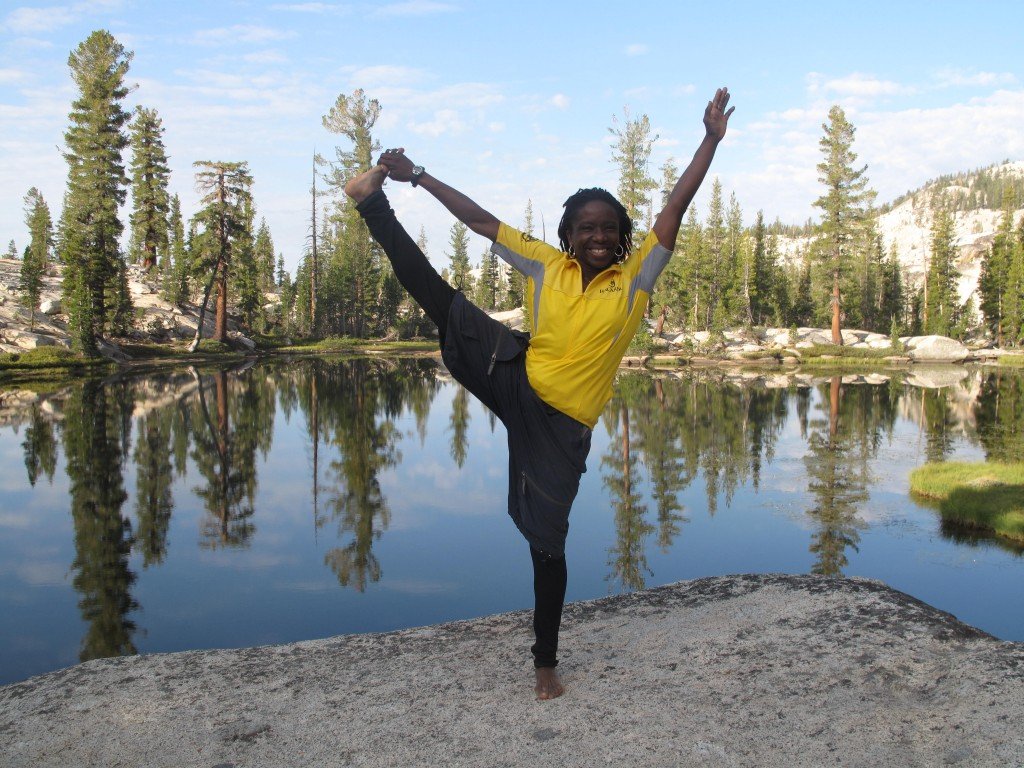Yoga as a Therapeutic Tool
How often do you go to a yoga class and leave feeling better than when you arrived? Have you ever wondered why this occurs? When asked why they practice yoga, people give a variety of responses from fitness to spirituality, yet most of them agree that yoga makes them feel better.
Feeling good on Balanced Rock’s Women of Color Yoga & Wilderness Retreat
There are three things that happen in most yoga classes that cumulatively cause us to feel better: mindful action, mindful breathing, and mindful centering. Moving our physical body with an awareness of what we are doing brings us back into relationship with our kinesthetic sensibility and with the body that we inhabit. For years we may have been disconnected with this body, and returning to an awareness of ourselves physically can be deeply healing in and of itself. It can also be difficult and tremendously frightening, particularly if our body has experienced trauma that has been lodged into the evolutionarily less developed portions of our brains that process fear and the ‘fight or flight response’. Combining physical movement with breath directly accesses these portions of the human brain called the brain stem and limbic system. So by engaging in yoga we are healing on subconscious levels. This is why we often leave the yoga class feeling better than when we arrived, but can’t even explain what has occurred. Of course, human beings are highly intelligent and we have a deep interest in our own experience, so for healing to occur completely we will inevitably need to bring it into conscious consideration or understanding. Using the tool of mindful centering, or focusing our mind on one thing, alters brain waves in our pre-frontal cortex. It completes the process of vertical integration that brings about healing on physical, mental and emotional levels leading to improved emotional regulation.
What is happening “behind the scenes” is that the human body is constantly trying to maintain homeostasis or balance. When we are stimulated we require rest to bring balance back to the system. Conversely when are sedentary we may enter a period of stagnation and require some energetic movement to rouse ourselves back into balance. In the Krishnamacarya and ViniYoga traditions (both highly regarded for their therapeutic approach to yoga), yoga sequences and practices are often characterized as creating one of two energetic qualities; brahmana or langhana.
Brahmana means expansion, and practices that are brahmana in nature increase vitality and build energy in the body.
These are more energizing, stimulate the metabolism and the nervous system, and balance tamas. These practices tend to be warming for the body and activating for the mind. Yoga asanas that intrinsically build the energy of brahmana include backbends and many inversions. Pranayamas that intrinsically build the energy of brahmana include kapalbhati, bhastrika, and surya bedhana.
Langhana means reduction and practices that have a langhana quality are grounding and calming.
They slow down the metabolism, heart rate, respiration rate, relax the nervous system, and balance rajas. Asanas that intrinsically build the energy of langhana include forward bends, and restorative postures. Pranayamas that intrinsically build the energy of langhana include vishama-vrrti, sitali, sitakari, and chandra bedhana. Depending on the focus, pace, breathing pattern, and intention, many practices can have either a brahmana or langhana quality. Determining whether we need practices that are more brahmana or more langhana will depend on our state of being in the moment and what will bring us closer to homeostasis.
Homeostasis and disease are connected because the body is generally out of homeostasis when it has a disease. All people experience disease, pain and suffering at some point in their lives, both on physical and psychological levels. Yoga offers a full spectrum of tools to engage with disease and pain in an intelligent and effective way. One of the first great yoga instructors teaching in the west, BKS Iyengar wrote:
Pain is there as a teacher, because life is filled with pain...Since pain is inevitable, [yoga] asana is a laboratory in which we discover how to tolerate the pain that cannot be avoided and how to transform the pain that can.
We can not escape pain in this human condition, so rather than expend effort on trying to do so through medication or avoidance, we can utilize the tools that yoga offers to engage with it fully and better understand when and how we can better tolerate or transform it. While you may continue to enjoy yoga as a subconsciously therapeutic practice by simply attending yoga classes and emerging feeling better than when you arrived, you can also dive in deep and avail yourself consciously of these powerful tools to better understand yourself and heal in an integrated way physically, mentally and emotionally. In fact this may be the best hope we have for healing the wounds of our modern world, by embarking on the journey of healing ourselves one breath at a time.
Balanced Rock is offering a donation-based workshop on Yoga as a Therapeutic Tool, April 27th 6:00pm-8:00pm at the El Portal Community Hall.
References:
Yoga, Personal Transformation and Global Sustainability. BK Bose, MW King, R Schware. Can be found at: http://niroga.org/media/news/2014Yoga_Personal_Transformation_Global_Sustainability.pdfYoga for Healthy Digestion Practices. B Bell. Can be found at: http://yogaforhealthyaging.blogspot.com/2013/09/available-on-video-yoga-for-healthy.htmlLight on Life. BKS Iyengar. 2005.
Written by Paula Wild
Paula Wild, E-RYT 500, is honored to serve as Director of Operations, Instructor and Guide for Balanced Rock. She is a masterful yoga instructor and therapist who most deeply enjoys practicing and teaching in nature’s outdoor studio. She believes that the tools yoga and time in nature offer are the most effective ways to connect with our own inner wisdom and expand our potential in the world. Access Paula’s latest musings and offerings on her blog and website: wildawakewellness.com

